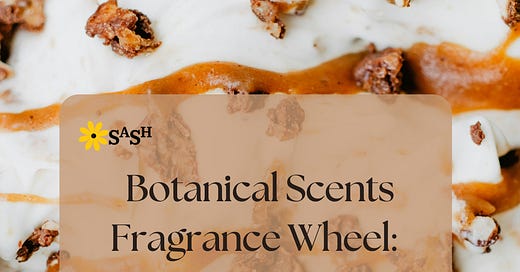A couple of weeks ago, we added the second part of the “second wheel” of my reimagined botanical scents fragrance wheel:
Building on the Botanical Scents Fragrance Wheel: Vintage
Last week, we added the first part of the “second wheel” of my reimagined botanical scents fragrance wheel:
The aim of this project is to reimagine the traditional fragrance wheel used by perfumers and make one that is suited specifically to botanical scents - used by botanical perfumers and aromatherapists.
Over the years that I have been studying botanical perfumery, I have come up with some of my own interpretations/understandings based on the traditional fragrance families/wheel, which - to me - fit more easily with botanical perfumery.
As I started to think about this project, I realized that my Botanical Scents Fragrance Wheel was going to divert from the traditional fragrance wheel by one major component. It would have a “central” wheel: Floral. The reason I came up with this was personal. The majority of my fragrances have a floral element.
Building on this central floral wheel, I added the second of five different categories - based on the traditional fragrance wheel but renamed to reflect both botanical and personal reasons. The first spoke of this wheel was BRIGHT. This week, we are looking at SWEET.
What is Sweet in Perfumery?
My interpretation of sweet in botanical perfumery for this project is an extract (essential oil, CO2, absolute or other type of botanical extract) which is reminiscent of gourmand aromas like vanilla, caramel, and chocolate. Some of these extracts might not be 100% sweet (they may have other elements within them, too) and it might be that you need to combine some extracts to produce a “sweet-like” fragrance as its main note. Berry can also be sweet.
One particular sweet aroma that I have recently become obsessed with - and am on a mission to recreate at some point in my fragrances - is salted caramel. It has a sickly sweet, butter, caramel taste (despite the “salted” element) and to recreate that in a fragrance would make it enticingly sublime!
Some straight extract examples which might contribute to a sweet aroma include:
vanilla absolute (Vanilla planifolia)
cacao bean (Theobroma cacao)
tonka bean (Dypterix odorata)
aniseed (Pimpinella anisum)
orange blossom (Citrus aurantium var. amara)
honey (Cera alba) (also in the vintage category)
raspberry leaf absolute (Rubus idaeus)
bright aromas such as lime (Citrus aurantifolia) and mandarin (Citrus nobilis) can also be sweet.
You can tincture some of these extracts, too (for example, vanilla). Examples of my fragrances which have a sweet element include Avid About Ava.
So, we now have the central floral “wheel”, the bright spoke, the vintage spoke and the sweet spoke. This looks something like this:
By the end of the journey, we will have put together a botanical scents fragrance wheel that you can exclusively use with botanical perfumery. However, remember that this is simply my own interpretation and there is no one size fits all.
BONUS: I will also be including a separate bonus wheel for paid subscribers!
Learning botanical scents and organizing them into some sort of reference tool is extremely useful as a perfumer.
Perfume formulation can be a puzzle - but it doesn’t have to be! By subscribing to and reading my short FREE articles each week, you’ll get nugget-sized pieces of information to build your scent tools. Upgrade to paid to take that learning deeper, and get examples of actual oils, absolutes, and extracts to build into your botanical scents fragrance wheel (in the coming months).
Please drop a heart below if you like this article, forward it to a friend, or invite someone to subscribe (and perhaps get a free month’s paid subscription for doing so!).
What did you learn from this article? Drop me your thoughts in the comments below.
“My wife said, 'Take me in your arms and whisper something soft and sweet.' I said, 'chocolate fudge.’”
Tommy Cooper (1921-1984), British comedian







